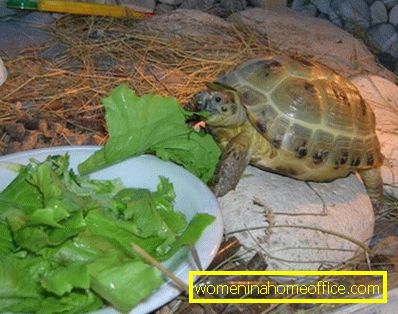What to feed turtles
Few people dislike animals, trying to shelter a homeless kitten or puppy, or vice versa, following the fashion, buying a pedigree pocket dog. The modern trend on the exotic brings its own nuances. And increasingly, instead of a dog in the apartment, you can see an iguana, a snake or a turtle.
How to feed turtles: diet by type
According to the type of food, all types of turtles can be divided into 3 types:
Predatory. The diet of this species consists of 70 - 90 percent of animal food, 10 - 30 percent of vegetable. In this group of turtles can be attributed almost all aquatic species and juveniles - trionyx, young red-eared, marsh, etc.
Omnivores. The diet of these species consists of both animal and plant foods, and 50 to 50 percent. Species that can be attributed to omnivores - adult red-eared turtles, marsh, prickly, red-legged, etc.
Herbivores. Do not think that herbivores do not need animal food, they are needed, but the percentage ratio with plant is low - only 5 percent. This group includes all types of land turtles, namely, Central Asian, radiant, Greek, spider, etc.

If you violate the diet and the percentage of ingredients, it is unhealthy for the health of the turtle. The consequences can be varied, from digestive problems, to the death of an animal due to metabolic disorders and various kinds of pathologies of internal organs.
Menu of land turtles
Land tortoises are herbivores, Central Asian and Mediterranean species belong to this species. As food for such animals can be edible plants, it is imperative to give vegetables, unsweetened fruits, vegetables. Almost 80 percent of the turtle's diet should be presented in the form of greenery - various types of salads.
It should be remembered that vegetables and fruits in the diet should appear much less frequently in comparison with greens, especially this rule is categorical in relation to fruits!
As a basic ration, turtles can be represented - dandelions, plantain, clover, zucchini, pumpkin, apples (but not sweet, sour-sweet), cucumbers and a bit of grated carrots can be offered.
As an additional food, you can use some types of mushrooms - russules, champignons. It is useful to give your pet a special balanced feed, which can be purchased in specialized stores, bran, dry sea kale and even young sunflower seeds, of course, not subjected to heat treatment.
Features feeding red-eared turtles
- The group of omnivores includes some species of land and semi-aquatic turtles - red-footed, adult marsh and red-eared. The exact percentage of feed types will depend on the contractual type. In specialized stores you can buy specialized food, which will be designed for a specific species of individual.
- It is worth remembering about the age of the tortoise, as the red-eared young individuals eat only animal food, but as an adult they must receive plant food as well, and this type of food should be 70 percent of the total diet. Fruits, vegetables, lettuce leaves, algae must be present as plant foods.
What do predatory turtles eat?
Predatory turtles often become pets. For such species as trionics, marsh turtles, the main food consists of animal food. Such turtles can be given lean fish, fish liver, beef, chicken, about 1 time per week. Fish for young turtles should be finely chopped, bones can be left only by removing the spine. For adults, fish can be given coarsely chopped into pieces or as a whole.

All marine products must be raw, without prior heat treatment. If you give shrimp to turtles, they should be fresh, not boiled. The only exception is the young red-eared turtles, which are completely irrelevant - boiled shrimp or not, no problems with digestion will not.
It is strictly forbidden to feed these pets sausages, sausages, pork, lamb, chicken, fatty fish, cheese and bread.
How to feed a domestic turtle: major mistakes
The main mistakes are connected with the ignorance of the turtle’s food, and the improper preparation of its diet. Often, herbivorous turtles are trying to feed animal food, but predators are exclusively vegetable. From here there are various kinds of problems with the health of the animal, until its death.
An equally common mistake is too frequent or, on the contrary, rare feeding. Over-feeding a turtle will provoke an individual's obesity, but under-feeding leads to exhaustion, an abnormal growth of the shell. Young turtles need to be fed daily, but adult individuals require less food - 2-3 times a week.
For the proper construction of the shell and for the proper functioning of the internal organs, turtles need vitamins and calcium. The absence of these trace elements in the diet leads to the formation of fractures, vitamin deficiencies and the formation of curved shell.
Turtles have recently become pets, and for these reasons, feeding and caring for them seems difficult, which is actually not the case. Modern stores are ready to provide everything you need for care, comfortable living and feeding of the individual.